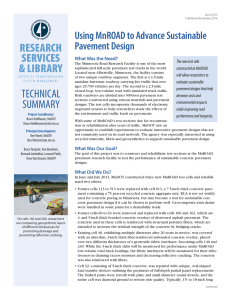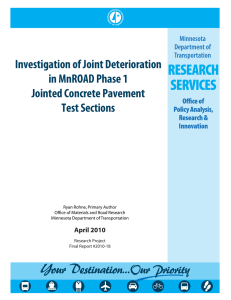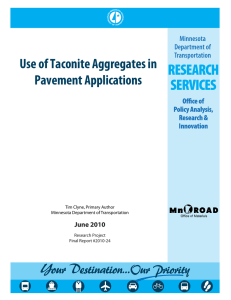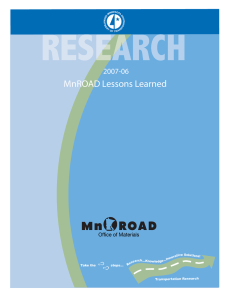TECHNICAL Improving the Quality of MnROAD Pavement Temperature Data What Was the Need?
advertisement
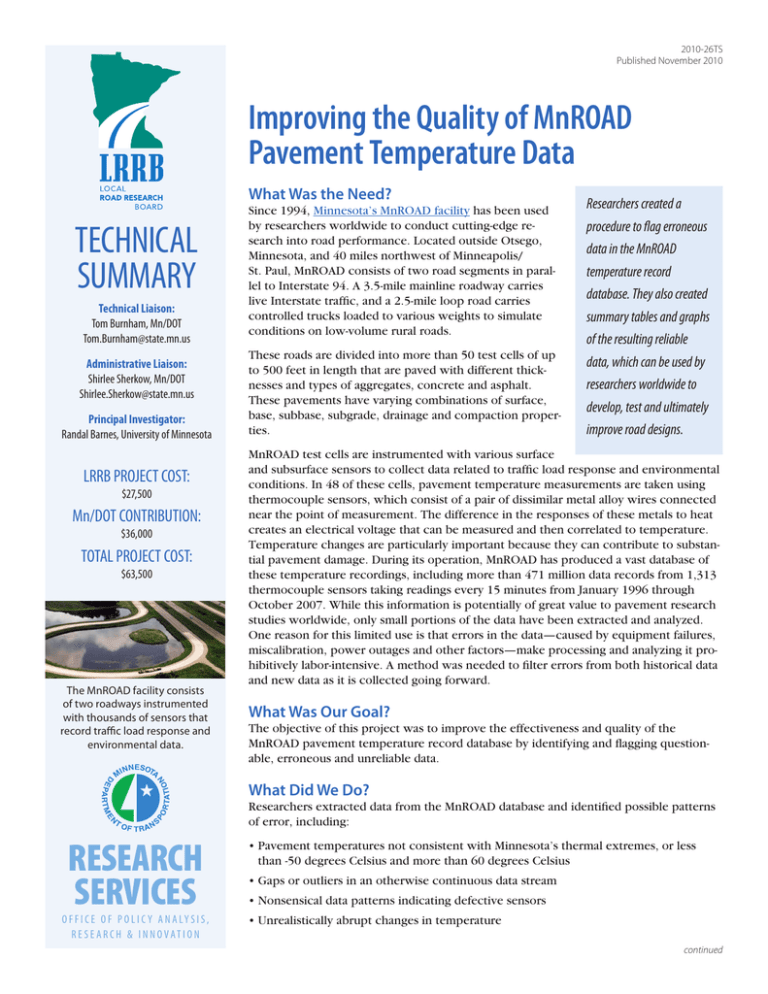
2010-26TS Published November 2010 Improving the Quality of MnROAD Pavement Temperature Data What Was the Need? TECHNICAL SUMMARY Technical Liaison: Tom Burnham, Mn/DOT Tom.Burnham@state.mn.us Administrative Liaison: Shirlee Sherkow, Mn/DOT Shirlee.Sherkow@state.mn.us Principal Investigator: Randal Barnes, University of Minnesota LRRB PROJECT COST: $27,500 Mn/DOT CONTRIBUTION: $36,000 TOTAL PROJECT COST: $63,500 The MnROAD facility consists of two roadways instrumented with thousands of sensors that record traffic load response and environmental data. Since 1994, Minnesota’s MnROAD facility has been used by researchers worldwide to conduct cutting-edge research into road performance. Located outside Otsego, Minnesota, and 40 miles northwest of Minneapolis/ St. Paul, MnROAD consists of two road segments in parallel to Interstate 94. A 3.5-mile mainline roadway carries live Interstate traffic, and a 2.5-mile loop road carries controlled trucks loaded to various weights to simulate conditions on low-volume rural roads. These roads are divided into more than 50 test cells of up to 500 feet in length that are paved with different thicknesses and types of aggregates, concrete and asphalt. These pavements have varying combinations of surface, base, subbase, subgrade, drainage and compaction properties. Researchers created a procedure to flag erroneous data in the MnROAD temperature record database. They also created summary tables and graphs of the resulting reliable data, which can be used by researchers worldwide to develop, test and ultimately improve road designs. MnROAD test cells are instrumented with various surface and subsurface sensors to collect data related to traffic load response and environmental conditions. In 48 of these cells, pavement temperature measurements are taken using thermocouple sensors, which consist of a pair of dissimilar metal alloy wires connected near the point of measurement. The difference in the responses of these metals to heat creates an electrical voltage that can be measured and then correlated to temperature. Temperature changes are particularly important because they can contribute to substantial pavement damage. During its operation, MnROAD has produced a vast database of these temperature recordings, including more than 471 million data records from 1,313 thermocouple sensors taking readings every 15 minutes from January 1996 through October 2007. While this information is potentially of great value to pavement research studies worldwide, only small portions of the data have been extracted and analyzed. One reason for this limited use is that errors in the data—caused by equipment failures, miscalibration, power outages and other factors—make processing and analyzing it prohibitively labor-intensive. A method was needed to filter errors from both historical data and new data as it is collected going forward. What Was Our Goal? The objective of this project was to improve the effectiveness and quality of the MnROAD pavement temperature record database by identifying and flagging questionable, erroneous and unreliable data. What Did We Do? Researchers extracted data from the MnROAD database and identified possible patterns of error, including: RESEARCH SERVICES O F F I C E O F P O L I C Y A N A LY S I S , R E SE A R C H & I N N OVAT I O N • Pavement temperatures not consistent with Minnesota’s thermal extremes, or less than -50 degrees Celsius and more than 60 degrees Celsius • Gaps or outliers in an otherwise continuous data stream • Nonsensical data patterns indicating defective sensors • Unrealistically abrupt changes in temperature continued “The temperature data collected at Mn/ROAD will be a huge asset for optimizing road design both in Minnesota and those places around the world with similar climates. The filtering processes produced by this project make this data more usable.” —Randal Barnes, Associate Professor, University of Minnesota Department of Civil Engineering “The size and impact of the MnROAD database affected by this project are comparable to the Long-Term Pavement Performance database, the premier information source in the United States for pavement performance data.” A thermocouple sensor (left) is typically mounted on a vertical tree (right) spanning surface and subsurface pavement layers, allowing temperature measurements at various depths. These vertical profiles are critical to fully relating pavement performance to temperature. • Differences in data streams taken during the same period by similar sensors, or by sensors located in comparable pavement types and at approximately the same depths and cell locations These patterns were used to create an algorithm and computer code that could be employed to filter the temperature database. This algorithm included 14 interdependent quantitative tests for flagging erroneous, questionable and exceptional data. Researchers filtered out erroneous data and used the remaining accurate data to produce a wide variety of statistical tables and graphs. They also created a user’s guide for researchers wishing to make use of this data along with the algorithms and computer code used to filter it. What Did We Learn? The majority of the pavement temperature sensors performed very well. Of the 1,282 operational sensors, 714 produced reliable data more than 99 percent of the time. Only 18 of 1,282 operational sensors produced reliable data less than 50 percent of the time. Only 31 of the original 1,313 sensors were wholly nonoperational. What’s Next? —Tom Burnham, The MnROAD temperature database contains information that is invaluable to in-depth research about the response of pavements to cold climates. Now that this data has been filtered, MnROAD can share it in a convenient digital format with researchers around the world, allowing them to develop and test new pavement designs that could improve road performance. Although this project focuses on an existing set of data, the system developed for it can also be used for ongoing filtering of temperature data as it is collected at MnROAD. Produced by CTC & Associates for: Minnesota Department of Transportation Research Services Section MS 330, First Floor 395 John Ireland Blvd. St. Paul, MN 55155-1899 (651) 366-3780 www.research.dot.state.mn.us Because of the success of this project, researchers have not yet determined whether a second phase will be required. Ongoing related research includes the Vibrating Wire and Horizontal Clip Data Analysis project, in which researchers are analyzing MnROAD data from vibrating wire and horizontal clip sensors—used to measure pavement strain and structural changes—to flag anomalies and develop similar validation software. Mn/DOT Senior Road Research Engineer This Technical Summary pertains to the LRRB-produced Report 2010-26, “MnROAD Data Mining, Evaluation and Quantification—Phase I,” published July 2010. The full report can be accessed at http://www.lrrb.org/PDF/201026.pdf.

